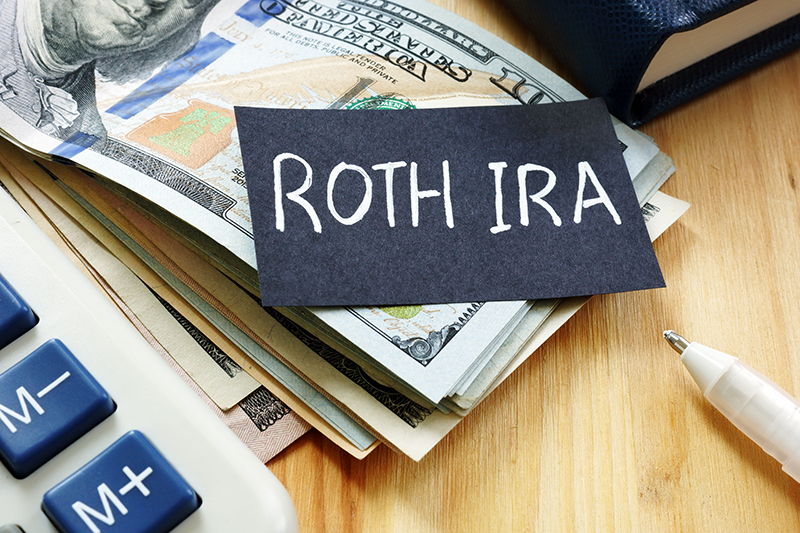Can I Deduct Roth IRA Contributions?
August, 21 2024 by Carolyn Richardson, EA, MBA
If you’re like most Americans, you probably feel like you don’t have enough saved for your retirement. And like many Americans, you’re also probably trying to figure out ways to lower the amount of taxes you pay to the IRS. So, you may be eyeing a Roth IRA as a means to accomplish both of these things, but will a Roth IRA really do so?
Roth IRAs have long been the darling of the financial planning world – primarily because distributions from a Roth IRA are generally not taxable income, providing you meet a holding period which we’ll explain a little later in this blog. As such, Roth IRAs have the potential to avoid generating large tax bills when a person is retired and possibly not able to pay a large tax bill. But does a Roth IRA also lower your taxes now, when you are in your prime earning years? Because the distributions from a Roth IRA are usually not taxable, contributions you make to them are also not deductible. That’s the unfortunate truth behind most tax law – you don’t get to take tax deductions now and receive a nontaxable benefit later when distributions are required. But focusing only on the lost tax deduction in deciding whether or not to contribute to a Roth IRA may be shortsighted.
The most you can contribute to a Roth IRA for 2024 is $7,000, or $8,000 if you are age 50 or older. This additional $1,000 boost is called a “catch-up” contribution. That may not sound like much given how expensive everything is but, through the miracle of compound interest, if you start early enough in making contributions, it can grow substantially before you retire.
Who Can Make a Roth IRA Contribution?
The good news is that, in general, most taxpayers who have earned income can potentially make a Roth IRA contribution. You can also make a contribution for your non-working spouse. Unlike traditional IRAs, where your ability to deduct the contribution is contingent not only on your earned income but also on your existing pension or retirement plan coverage, Roth IRAs only depend on your income.
What do we mean by earned income? Earned income, in this sense, for purposes of making a Roth IRA contribution, essentially means money you earn from working, whether that is as an employee, self-employed, or partner in a partnership (as long as you are actively working for the partnership in a meaningful way and your interest in the partnership isn’t considered to be merely an investment). It also includes taxable alimony payments you receive from a former spouse, taxable non-tuition fellowship and stipend payments, and nontaxable combat pay. It does not include income from investments such as rental properties, dividends or interest, retirement income such as pensions or annuities, and most types of nontaxable income.
Making too much money can also limit whether you can contribute to a Roth IRA. Like traditional IRAs, there is a maximum adjusted gross income (called Modified Adjusted Gross Income (MAGI) you can earn before you are ineligible to make a contribution to a Roth IRA, and that amount depends on your filing status. Modified AGI is your regular AGI plus any traditional IRA deduction, student loan interest deductions, the foreign earned income exclusion or housing exclusion or deduction, excludable U.S. Savings bond interest used for education, and excluded employer-provided adoption benefits. For 2024, a single taxpayer, one claiming the head of household filing status, or a married taxpayer who files separately and does not live with their spouse at any time of the year, can earn up to $146,000 before the contribution is limited, and a partial contribution if their income is over $146,000, but less than$161,000. Once their modified adjusted gross income is $161,000 or greater, no contributions are allowed. For taxpayers filing a joint return or who are qualified surviving spouses, you earn up to $230,000 before your contribution is limited, and a partial contribution if their income is over $230,000 but below $240,000. If your joint income is more than $240,000, you cannot make a contribution. If you DO live with your spouse at any time during the tax year and file separately, the income limitation reduces drastically to $0-$10,000. If your income is between these ranges, you can make a reduced contribution. You can find a worksheet to figure out your actual deduction in IRS Publication 590-A, Contributions to Individual Retirement Arrangements.
What if I Make Too Much Money?
Even if your MAGI exceeds the limits above, you may still be able to make a Roth IRA contribution. This is called making a “back-door” Roth IRA contribution. To make a back-door Roth IRA contribution, you make a nondeductible traditional IRA contribution first. Once the contribution is made, you can then do a Roth IRA conversion, which is where you convert your traditional IRA account (with basis) into a Roth IRA account. Roth IRA conversions have no income limitations, unlike Roth IRA contributions. A Roth IRA conversion is a taxable event for any contributions to an IRA that were deducted in prior or current tax years, but not taxable to the extent you made nondeductible contributions.
Nondeductible contributions to a traditional IRA must be reported on your tax return on Form 8606, Nondeductible IRAs. This creates a basis in your traditional IRA and, if you left it there, you would need to track it from year to year so that once you start receiving taxable distributions from your IRA, you can treat a portion of it as nontaxable since you received no tax benefit from it when the contribution was originally made. Let’s look at an example: Jerry, age 40, is a single taxpayer and his MAGI for 2024 is $165,000, and he is covered by his employer’s 401(k) plan. Because of the 401(k), Jerry cannot make a deductible contribution to a traditional IRA since he is over those income limits. So, Jerry wants to make a Roth IRA contribution, but he is just over the MAGI limitation for 2024 to make one. Jerry has no other traditional IRAS, so he makes a $7,000 nondeductible contribution to a traditional IRA on April 14, 2025, for the 2024 tax year, and reports it on his 2024 tax return by including Form 8606 when he files his return on April 15, 2025. On April 16, 2025, Jerry converts his traditional IRA to a Roth IRA, when the new traditional IRA is worth $7,025. On the conversion, Jerry would have a taxable conversion of $25, on his 2025 tax return. The $7,000 is basis in the traditional IRA and is not taxable.
Keep in mind, however, that this strategy only works if you have NO other traditional IRAs other than the one created for the back-door conversion. If Jerry had other traditional IRAS (for example, from converting a former employer’s 401(k) to an IRA), the value of that IRA must be considered to determine how much of his basis from the nondeductible IRA contribution can be allocated to the conversion. If Jerry had $100,000 in another traditional IRA (for total traditional IRAs of $107,025), 93.44% of his conversion amount would be taxable ($6,564) rather than just the $25 of earnings.
Why Should I Make a Roth IRA Contribution?
 As we stated previously, because the contributions to a Roth IRA are not deductible, the earnings in the Roth IRA are also generally not taxable when withdrawn in retirement. However, to take a nontaxable distribution, you must be age 59½ or older and you must have had a Roth IRA for five years before the distribution. There are exceptions to the age rule if the distribution is made due to death or disability of the Roth IRA owner, or for first-time homebuyers, but there is no exception to the 5-year rule. If you do not meet these rules, the distribution is subject to a 10% early distribution penalty for the taxable portion of the distribution.
As we stated previously, because the contributions to a Roth IRA are not deductible, the earnings in the Roth IRA are also generally not taxable when withdrawn in retirement. However, to take a nontaxable distribution, you must be age 59½ or older and you must have had a Roth IRA for five years before the distribution. There are exceptions to the age rule if the distribution is made due to death or disability of the Roth IRA owner, or for first-time homebuyers, but there is no exception to the 5-year rule. If you do not meet these rules, the distribution is subject to a 10% early distribution penalty for the taxable portion of the distribution.
And another benefit of Roth IRAs is that there are no required minimum distributions, unlike traditional IRAs, so if you don’t need the money in your retirement, you can leave it in the account. Roth IRAs generally follow the other limitations that traditional IRAs have, such as how the account is distributed to your beneficiaries when you die. If your beneficiary is your spouse, they can elect to treat your Roth IRA as their own IRA and continue making contributions to it. If your beneficiary is not your spouse, a Roth IRA must be fully distributed to your beneficiary within 5 years of your date of death. Unlike a traditional IRA, these distributions are not taxable to your beneficiary regardless of whether they are your spouse or not.
Regardless of your age or income, it’s worthwhile to start a Roth IRA as soon as possible! Even if you contribute only $100 to the Roth IRA, it starts the five-year holding period, and that holding period will apply to any other Roth IRA you create later. You may be a poor college student now and not able to make substantial contributions to any kind of retirement account, but you don’t know where you’ll be in the future and having the ability to withdraw that money tax-free when you are in your 60s may be the best thing you can do for yourself. And for an older taxpayer, a Roth IRA may not make any financial sense depending on their other retirement income. As with most retirement planning, it’s a good idea to check with your financial planner to make sure a Roth IRA makes sense for you.
So, what are you waiting for?





